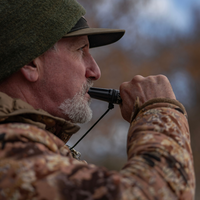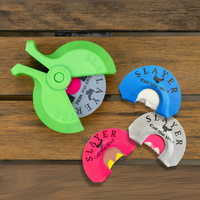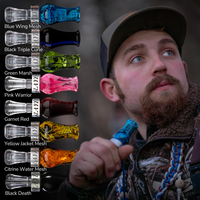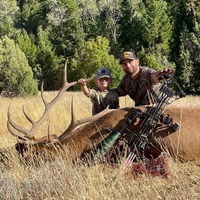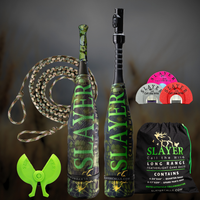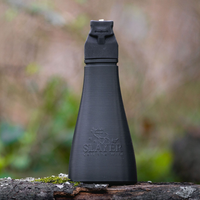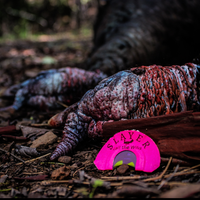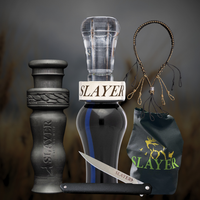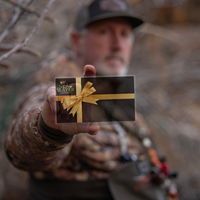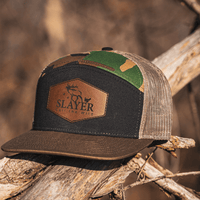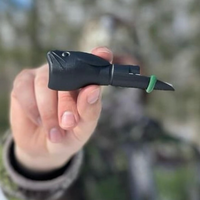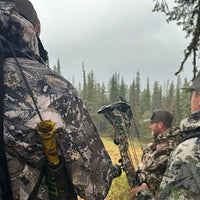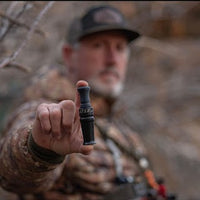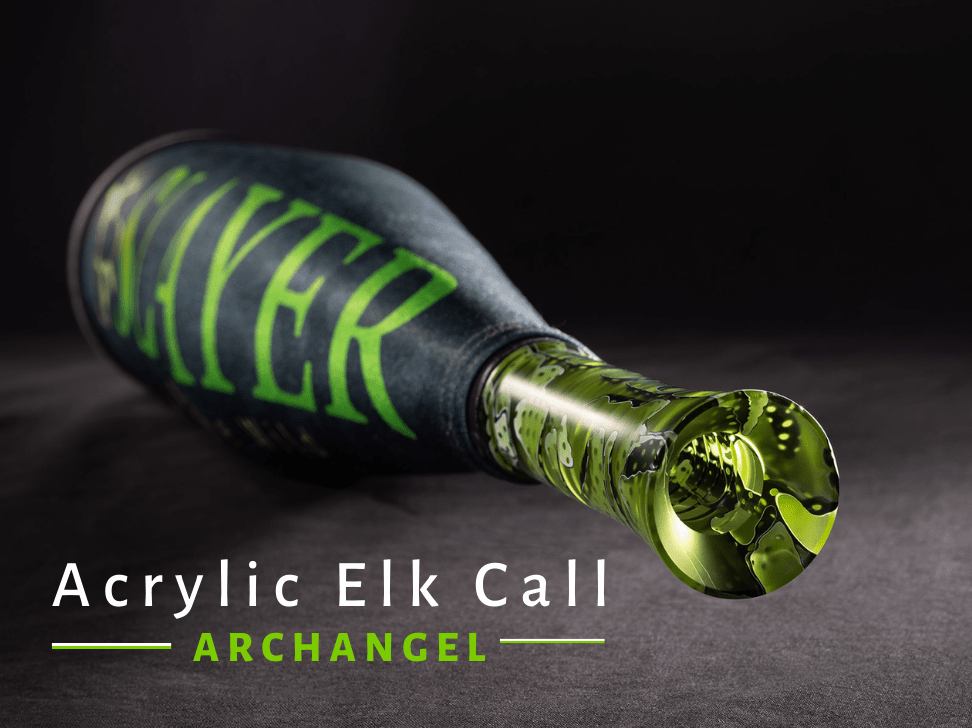Choosing your first elk call: Tips for external calls, internal calls and bugles
By M.D. Johnson If you’ve decided to venture out of your “comfort zone” of ducks, geese and gobblers in favor of hunting your first elk, congratulations are in order! Sure you’ve been challenged before — weather, stale birds, henned-up toms, hunting pressure and miles upon miles boated, biked, hiked, glassed — but trust me: now you’re in for something altogether different. Hot one day, ice-cold the next, elk can take you from zero to hero and back to zero in the blink of an eye. But there are ways you can sway the odds in your favor — at least a bit. Getting in good physical condition, scouting ahead, becoming proficient with your weapon of choice, etc. Among these, researching and purchasing your first elk call. But where to begin? Let’s look at the basic types of elk calls, and go from there.External calls
 The name — external — is the first clue here, as this style of call is operated outside the mouth. External calls may be entirely operated by hand, often by squeezing a rubber or plastic bulb that then forces a current of air over a reed or reeds, thus creating the desired sounds.
External calls may also involve air (breath) being physically blown into the device; again, causing the reed or reeds to vibrate and produce “elk language,” (i.e., the chirps and mews that elk — primarily cows and calves — use to communicate within the herd). General consensus is either style is user-friendly; however, both still require practice and patience.
There are two primary types of air-operated external calls: open reeds (with an open or exposed mylar reed) and the “bite” style, which employs a similarly-shaped mylar reed — think duck call reed! — housed inside a rubber tube. Biting or applying pressure to the rubber tube at different points along its length changes the tone and pitch of the call produced. Many (myself included) find the bite style call to be easier; still, some believe open reeds can be more versatile in the sounds they create.
The name — external — is the first clue here, as this style of call is operated outside the mouth. External calls may be entirely operated by hand, often by squeezing a rubber or plastic bulb that then forces a current of air over a reed or reeds, thus creating the desired sounds.
External calls may also involve air (breath) being physically blown into the device; again, causing the reed or reeds to vibrate and produce “elk language,” (i.e., the chirps and mews that elk — primarily cows and calves — use to communicate within the herd). General consensus is either style is user-friendly; however, both still require practice and patience.
There are two primary types of air-operated external calls: open reeds (with an open or exposed mylar reed) and the “bite” style, which employs a similarly-shaped mylar reed — think duck call reed! — housed inside a rubber tube. Biting or applying pressure to the rubber tube at different points along its length changes the tone and pitch of the call produced. Many (myself included) find the bite style call to be easier; still, some believe open reeds can be more versatile in the sounds they create.
Internal / reed elk calls
Also known as diaphragm calls, these horseshoe-shaped pieces of metal, latex rubber, and textured tape are, for those familiar with them, identical to the diaphragm calls used by turkey hunters (e.g., Slayer Calls’ Black Bat Wing or Snake Bite diaphragm calls). Diaphragm calls are placed on the roof of the caller’s mouth (internal), and pressure is applied to the reed/reeds with the tongue while air is forced through the gap created. More pressure equals a higher pitch; less pressure, a lower pitch. Internal elk calls offer several advantages over external calls, yet there are less-than-user-friendly trade-offs that come with these excellent little devices. Here are the pros and cons. Pros:
Pros:
- Hands-free operation allows for aiming/drawing
- Hands-free operation eliminates elk-spooking calling movement
- Unaffected by weather conditions
- Extremely versatile in the range of sounds created
- One size does not fit all; the trick is finding an internal call that fits properly
- There is definitely a learning curve involved with internal/diaphragm calls
Bugle tubes
 Biologically, a bull elk forces air from his lungs, up through his windpipe and out his mouth, using a combination of tongue and throat pressure to cause the rise and fall of the extraordinary sound known as the bugle. It’s a combination of things, but largely it’s the bull’s windpipe that adds much depth, resonance, body and inflection to the sound.
Humans, obviously, lack the bull’s windpipe; however, we compensate for that missing part of the aural puzzle with an artificial windpipe. Enter: the bugle tube.
Typically constructed of a strong, lightweight, corrugated plastic, with either a straight or megaphone-shaped end, the bugle tube is used in conjunction with a diaphragm (internal) call in an effort to reproduce the exact depth of the bull’s bugle. These innovative instruments (e.g., Slayer Calls’ Swagger Bugle Tube), allow for a greater range of inflection and realism, as well as adding calling distance when needed.
Biologically, a bull elk forces air from his lungs, up through his windpipe and out his mouth, using a combination of tongue and throat pressure to cause the rise and fall of the extraordinary sound known as the bugle. It’s a combination of things, but largely it’s the bull’s windpipe that adds much depth, resonance, body and inflection to the sound.
Humans, obviously, lack the bull’s windpipe; however, we compensate for that missing part of the aural puzzle with an artificial windpipe. Enter: the bugle tube.
Typically constructed of a strong, lightweight, corrugated plastic, with either a straight or megaphone-shaped end, the bugle tube is used in conjunction with a diaphragm (internal) call in an effort to reproduce the exact depth of the bull’s bugle. These innovative instruments (e.g., Slayer Calls’ Swagger Bugle Tube), allow for a greater range of inflection and realism, as well as adding calling distance when needed.
Or, give Slayer's ArchAngel elk call a try. This acrylic bugle elk call enables callers to have much better control of the reed which, combined with Slayer's tried and tested acrylic material, means hunters can create loud, realistic sounds. Simply drawing air back against the rifling in the acrylic when chuckling, grunting, or panting produces scary-realistic, deep, and guttural bull elk diaphragm sounds. With this acrylic bugle elk call, you’ll be able to scale up octaves with ease and reach some of the highest notes ever achieved. The acrylic material also eliminates all that plastic sound that is common among other bugles.
It’s easy to become overwhelmed with today’s wide variety of elk calling tools that are available; however, the best advice when it comes to choosing a call and then learning to use that call from a technical standpoint — Note: The field work will come later — is to find one style and become proficient with it before progressing onto the next. Season’s coming, but you have time.Meet M.D. Johnson
 Originally from Ohio, M.D. Johnson, and his wife/business partner, Julia, spent 18 years in Iowa before relocating to her native Washington state in 2015. A full-time freelance outdoor writer since 1992, Johnson, with the photographic assistance of his wife, has authored and illustrated six full-length books, including three on waterfowl hunting. Today, The Johnsons reside in Wahkiakum County, where they both enjoy a 107-day duck season, salmon fishing, and everything the wonderful Pacific Northwest has to offer. Oh, and if you ask, M.D. will tell you he prefers 16 gauge doubles to anything else.
If you enjoyed this article, check out this other articles:
Originally from Ohio, M.D. Johnson, and his wife/business partner, Julia, spent 18 years in Iowa before relocating to her native Washington state in 2015. A full-time freelance outdoor writer since 1992, Johnson, with the photographic assistance of his wife, has authored and illustrated six full-length books, including three on waterfowl hunting. Today, The Johnsons reside in Wahkiakum County, where they both enjoy a 107-day duck season, salmon fishing, and everything the wonderful Pacific Northwest has to offer. Oh, and if you ask, M.D. will tell you he prefers 16 gauge doubles to anything else.
If you enjoyed this article, check out this other articles:
- Elk Hunting Tips for Beginners, by M.D. Johnson
- Archery Elk Hunt: 7 Tips for a First-Timer, by Scott Haugen
- You've Located a Bull...Now What?, by Scott Haugen
